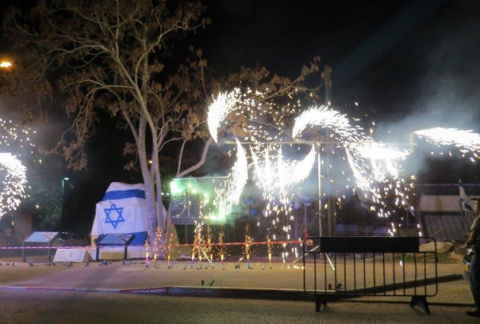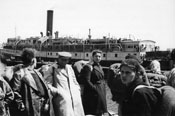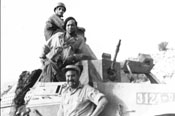Aliyah Bet & Machal Virtual Museum
North American Volunteers In Israel's War of Independence
More Coverage of the Jerusalem Machal Memorial Dedication

Machal Fighters Get Memorial in Jerusalem, Seven Decades After Volunteering for Israel
BY TOM TUGEND | PUBLISHED DEC 13, 2017 | NATION/WORLD (JEWISH JOURNAL)
Nearly 70 years after volunteers from five continents left homes and jobs to fight for the newly proclaimed State of Israel, their deeds will be honored and memorialized on Dec. 17 at a historic site in Jerusalem.
The 4,922 volunteers from 59 countries were part of Machal — a Hebrew acronym for Overseas Volunteers — and 123 of them died in the line of duty. Less than a dozen elderly survivors are expected to attend the dedication of the massive memorial, located across the Ammunition Hill national memorial site.
The memorial is 10 feet long and 8 feet high, made of stone, concrete and steel, and inscribed in Hebrew with the words of Yitzhak Rabin. In a tribute to the volunteers, the late general and prime minister said, “You came to us when we needed you most, during those dark and uncertain days of our War of Independence.”
Dignitaries will include Jerusalem Mayor Nir Barkat; national Housing and Construction Minister Yoav Galant; Jeffrey Margolis, president of American Veterans for Israel Legacy Corp.; and Harold (Smoky) Simon, the WorldMachal chairman. The afternoon events will include a torch relay from the city center to the dedication site, honor detachments and music from the armed forces, and a Hanukkah lighting ceremony.
Before and during the War of Independence, which began in 1948, the largest contingents of volunteers came from the United States, South Africa, the United Kingdom, Canada and France. Almost all — including 168 gentiles — had fought for their home countries in World War II and brought valuable experience and skills, particularly to the Israeli air force and navy, which had to be built from scratch.
Over the decades, the contributions of the volunteers to the outcome of the war either have been ignored in Israel and their home countries, or overblown, Hollywood-style.
A blunt and only slightly exaggerated description came from California novelist Harold Livingston, who flew for the Israel Air Transport Command and who described “Ben-Gurion’s Foreign Legion. They took anyone. Misfits from America, English communists, South African Zionists, Soviet army deserters, Polish noblemen, ne’er-do-well soldiers of fortune.
“If you want excitement and adventure, come on over. … If you want to write a book. If you’re running from the police. If you want to get away from your wife. If you want to prove that Jews can fight. If you want to build a new land.”
Perhaps Machal’s most important contribution was to lift the morale of Israelis, knowing that their Diaspora brethren were with them.
The motives always were mixed. My time as an American infantryman in France and Germany during World War II had left me restless, my early exposure to Zionism in a Jewish school and youth organization in Berlin during the mid-1930s had left an imprint, and since a new Jewish state arises only every 2,000 years or so, I figured I probably wouldn’t be around for the next time.
My past military experience qualified me to serve as squad leader in an “Anglo-Saxon” anti-tank unit, composed entirely of English-speaking volunteers, who spoke the mother tongue in a variety of often-incomprehensible accents. In this unit, the men from the highly organized and supportive Jewish communities of South Africa formed the most stable element; the Americans, Canadians and Brits were somewhere in the middle, while two teenage Australians arrived fairly late in the game after a slow ship ride from Down Under.
Machalniks served in all branches of the Israel Defense Forces — army, navy, air force, Palmach shock troops and medical corps — as well as Aliyah Bet, composed of men and women who ran the British blockade in 1946-47 to bring “illegal” Jewish immigrants to pre-state Palestine.
The single largest Machal contingent came from the United States. Its given numbers have varied acceding to time and source, some running as high as 1,400. In the most current compilation, Machal world chair Simon has downsized the figure to 805. Of these, 263 served in the air force, with many hailing from the Los Angeles area.
But given the size of the American Jewish community at the time, this number lags well behind the contribution of every other English-speaking country proportionally. For example, the South African contingent was almost as large as the American, with a Jewish population one-fiftieth that of the U.S.
Americans gave freely of their money, and a few lost their citizenships for illegally sending arms and planes to Israel.
But the disparity in the number of American volunteers reflected the differences in communal attitudes and civic courage. South African Jews — and Britain’s to a slightly lesser degree — set up their own selective service systems, complete with physical and psychological testing, and rallied fully behind their young men and women heading for the battlefield. By contrast, organized American Jewry, fearful of the dreaded accusation of double loyalty, generally averted its collective eyes and prayed silently that those crazy kids going over would not prove an embarrassment.
Whatever the Machal contributions, on the ground — where ultimately wars are still won — the Israelis did most of the job themselves and paid a high price. The War of Independence claimed the lives of some 6,200 Israeli soldiers and civilians.
Perhaps Machal’s most important contribution was to lift the morale of Israelis, knowing that their Diaspora brethren were with them.
One of the key initiators and backers of the Machal memorial has been Jerry Klinger, a son of Holocaust survivors, retired first vice president of Merrill Lynch and president of the Jewish American Society for Historic Preservation.
Klinger, who lives in Boynton Beach, Fla., has made it his mission to cut red tape and to fund and affix signposts and markers across the the world to draw attention to Jewish contributions and pioneering enterprises. He was instrumental in erecting a memorial in Haifa to the fabled refugee ship Exodus, as well as 66 historical markers throughout the West and the United States.
To Klinger, looking back on all his historical markers, the one honoring the men and women of Machal may be the most important. “If we let them be forgotten,” he said, “we are denying their tomorrows and our yesterdays.”
DEDICATION OF A MACHAL MEMORIAL AT AMMUNITION HILL IN JERUSALEM
By Doreen Bliss
On Sunday 17th December 2017, a Machal Memorial was dedicated to the 4,800 volunteers who came from 59 countries to serve in Israel’s War of Independence, 1948-49. These included the American and Canadian volunteers who served in Aliyah Bet manning the 10 ships which brought so-called “illegal immigrants” to Israel despite the British blockade.
The Memorial, which was sculpted by Sam Philipe (who also designed the Exodus Memorial at Haifa Port), was a project initiated by Jerry Klinger of the Jewish American Society for Historic Preservation with the assistance of the American Veterans of Israel Legacy Corp, in collaboration with the Jerusalem City Council.
The events commenced with an opening ceremony at the Western Wall (Kotel) followed by a Torch Relay Race. The dedication ceremony took place at Ammunition Hill and was attended by prominent participants including the Mayor of Jerusalem, Nir Barkat, the IDF, Police Commanders, heads of Veteran organizations, and Smoky Simon, Chairman of World Machal.
L‑R: Sim Manor (Mandelzweig), Reuven Narunsky, and Freda Gates,
Volunteers from South Africa in 1948
The Hannukah candle-lighting ceremony was followed by blessings, a program of music and singing, and then the highlight of the program, the unveiling of the MachalMemorial - an emotional moment for those Machalniks from 1948 who served in the War of Independence.
- Log in to post comments

 Back to News
Back to News


 Contact Us
Contact Us
 In a personal essay, Aliyah Bet and Machal Archives Director Ralph Lowenstein discusses the reasons why so few persons have ever heard of the thousand or so volunteers from North America who played a role in the winning of the War of Independence.
In a personal essay, Aliyah Bet and Machal Archives Director Ralph Lowenstein discusses the reasons why so few persons have ever heard of the thousand or so volunteers from North America who played a role in the winning of the War of Independence.